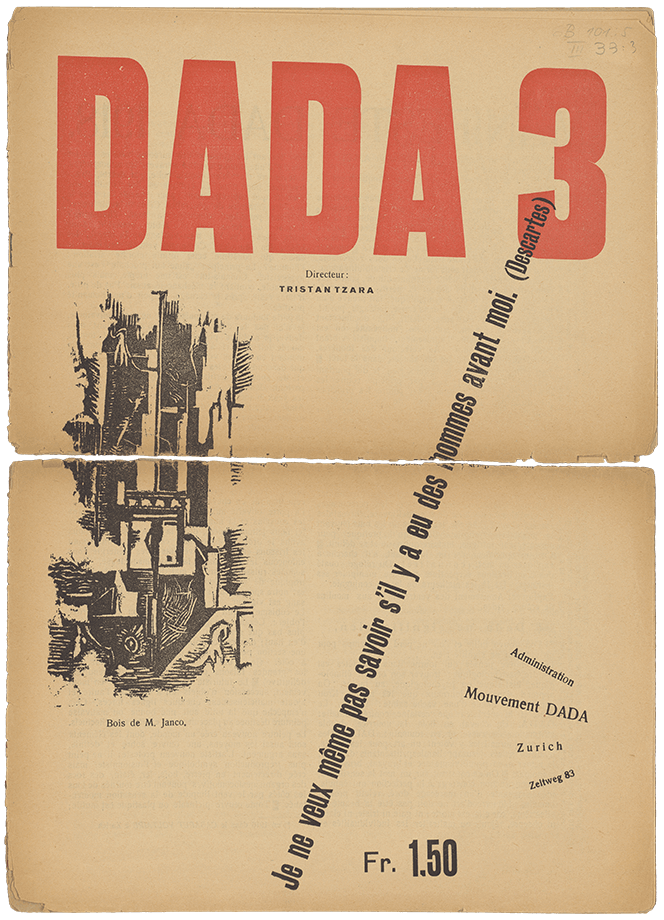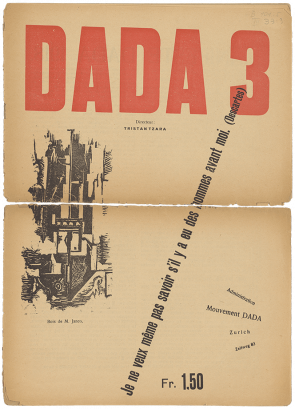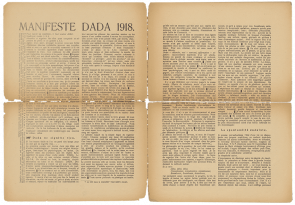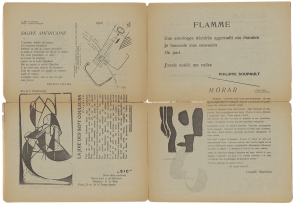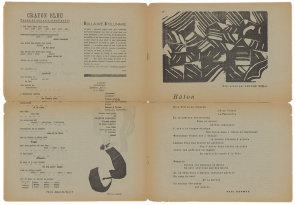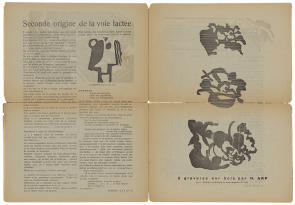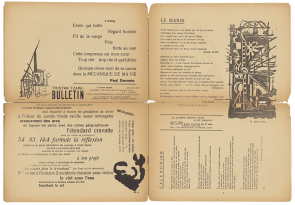With its third issue, which was published in December 1918, the magazine Dada changed its appearance. Its format was now larger, and its typography, compared to the classically set Dada 1 (July 1917) and Dada 2 (December 1917), distinctly experimental: we come upon diagonal lines and entire texts presented at right angles to the rest; the solution for the title is conspicuous in a modern way, and the interplay between word and picture is freer. The collaboration with the printer Wilhelm Julius Heuberger (1888–1965), whose small facility had been trusted with all Dada publications, had proved successful. The intervals between the numbers remained irregular. “As only very limited financial resources are available to us our publication is forthcoming quite rarely” (Tristan Tzara). The publication of Dada 3 was additionally delayed as Heuberger, a communist, was taken into preventive custody before the outbreak of the general strike. Dada 4–5 came out in May 1919; the issues 6, 7, and 8 were published in Paris after Tzara’s relocation from 1920 on.
The third number of the magazine clearly carries Tzara’s thumbprint. He boldly put his name as “Directeur” between his companion Marcel Janco’s woodcut and an alleged quote of the rationalist René Descartes (1596–1650), which may be considered a motto for Dada in its radical breach with the past. It hints at the tabula rasa made in Manifeste Dada 1918, which Tzara put at the beginning of the magazine on pages one to three like a blast of trumpets. The manifesto caused quite a sensation across the Parisian avant-garde; a photograph shows Breton and his friends gathered around the infectious Dada 3 in an almost ostentatious manner. Numerous contributions from abroad evidence Tzara’s successful acquisition activities. Remarkable are the numerous woodcuts scattered throughout the magazine, new those by Hans Richter showing numerous Dada heads (two of them only in the German edition). Francis Picabia’s stay in Switzerland made itself felt: Tzara was very keen on getting in touch with him. Both wrote emphatic obituaries on Guillaume Apollinaire, who had died in November 1918.
Edition: According to Tristan Tzara (see his letter to Francis Picabia, September 7, 1918), Dada 3 was printed in an edition of two thousand copies. Newsprint, pages six to twelve of most copies on gray-greenish, somewhat thicker paper (1.50 CHF). A luxury edition of about twenty numbered copies was printed; its cardboard cover shows a stenciled gouache composition in brown tempera against a yellow-painted ground by Hans Arp. Each copy comprised two signed woodcuts on deckle-edged paper, one by Arp and the other by Christian Schad (20.– CHF). All German texts in the French edition (by Ferdinand Hardekopf, Jakob van Hoddis, Richard Huelsenbeck) were replaced with French and Italian ones in the French edition to guard against the French government’s censors. The Kunsthaus Zürich further holds a French edition with a woodcut by Marcel Janco hand-coloured by the artist as well as a cardboard cover of the luxury edition with a stenciled gouache composition by Hans Arp. Provenance: Dada 3 was purchased by the Kunsthaus Zürich at the auction “Items from the Library and Collection of Tristan Tzara (Kornfeld & Klipstein, Dokumentations-Bibliothek III, Bern)” in 1968.
→ Marcel Janco, poster for the soirée of Tristan Tzara at the Zunfthaus zur Meisen, DADA V:47
→ 391, Numéro 8, DADA III:31:8
→ Hans Richter, Dada-Kopf [Dada Head], Z.Inv. 1977/64
